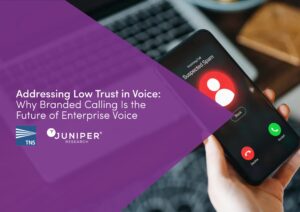Call center fraud has typically led enterprises to focus on inbound communications and invest in call center fraud detection and prevention tools. These measures shield customer-service channels from bad actors and prevent unauthorized account access.
But there is another angle to call center fraud that is becoming increasingly urgent for channel partners to address. This is spoof calling, which affects outbound calling operations when bad actors pretend to call from an enterprise’s legitimate number with the intention of deceiving and defrauding consumers.
The Spoof Calling Challenge
According to TNS research, spoof calls and unwanted robocalls mean 72% of Americans never answer phone calls from a number they don’t recognize – a key symptom of call center fraud eroding voice channel trust. This erosion of trust in the voice channel is a growing pain point for enterprises, negatively impacting customer engagement, brand reputation, and their bottom line.
De-prioritizing the voice channel is not an option for businesses, especially those operating in high-touch industries such as financial services, healthcare, retail, hospitality and insurance.
Voice Remains the Preferred CX Channel
TNS’ research found that 64% of consumers prefer to engage with their financial services provider via a phone call over any other method. With similar research findings for healthcare (65%) and insurance (62%) providers, it is clear voice calls remain the most popular way for people to communicate with businesses, despite the continued growth of apps, websites and messaging channels.
Restoring trust in the voice channel, by tackling all aspects of call center fraud, and delivering a high-impact inbound/outbound customer engagement experience requires recognizing current market dynamics, as well as technology and process strategies to solve these challenges.
Tackling Call Center Fraud to Secure Customer Communications
As artificial intelligence (AI) makes impersonation in call center fraud more sophisticated, enterprises in high-touch industries seek solutions from the channel partner community that fortify the voice channel, strengthen their customer experience (CX) offerings, and equip customers with confidence to increase engagement.
This brand spoofing threat is highly relevant for channel providers serving the contact center enterprise. According to TNS’ recent survey of contact center decision-makers, 89% reported issues with fraudsters spoofing their business’s identity. Despite widespread concern over spam and fraud, 31% of respondents indicated their company is not using tools to prevent call spoofing.
This gap exists partly because contact center enterprises and other businesses have historically focused more on the inbound customer experience over the outbound customer experience, overlooking how call center fraud can exploit outbound channels. However, with 94% of call center managers and executives deeply concerned about the impact of spam and fraud on outbound calling, the pressure to secure voice communications is rising. Unfortunately, enterprises have no insight into how often or when their brand and telephone number inventory is being used to perpetrate fraudulent scams.
Enterprises must prioritize security and transparency to rebuild consumer trust in the voice channel. When the inbound and outbound aspects of call center fraud are addressed, trust is restored, stronger customer engagement, higher answer rates, better customer outcomes and revenue growth will follow.
Inbound CX and secure communications do not fully protect the enterprise or its customers, and the channel’s traditional customer engagement solution set is being undermined by outbound inefficiencies and disruptive robocall bad actors. However, within this challenge lies an opportunity: Empowering enterprises with a holistic, secure outbound communication solution that complements inbound to drive more meaningful, secure engagement.
A Holistic Inbound/Outbound Communications Strategy
As referenced, digital transformation of the customer experience can no longer bypass the voice channel. For the channel community, delivering high-impact customer engagement to the enterprise market and their contact centers requires not only a balanced inbound-outbound approach but also a foundational change in addressing the erosion of trust in voice communications as a strategic business issue, rather than just a technical challenge.
Outbound communications strategies from channel partners delivered to the enterprise market must integrate four core components – branded calls, call authentication, spoof protection, and call analytics – working together to verify legitimate calls, block fraudulent ones and provide analytics to improve calling practices.
- Branded Calling displays critical call information, such as the brand name and logo, so recipients can identify the caller and feel confident answering. By branding calls, contact center operators and their parent organizations reestablish trust with recipients, prompting customers to recognize the call’s origin and feel confident answering.
- Call Authentication verifies each outgoing call from an authorized number, eliminating consumer uncertainty and reducing fraudulent robocalls.
- Spoof Protection ensures unauthorized calls are blocked before they reach customers, preventing fraudsters from making contact.
- AI-driven Call Analytics and Machine Learning generate call reputation profiles to distinguish legitimate calls from fraudulent ones.
Effective outbound communication delivers a range of impactful benefits for businesses and their customers.
3 Benefits of Secure Outbound Communication
1. Boosts Answer Rates and Engagement
According to TNS research, seventy-three percent of consumers would answer a call if the organization’s name was displayed on the call screen, while more than 8 in 10 (81%) of consumers would answer a call if it followed a recent action they had taken with that brand. These data points affirm that, despite the challenges posed by robocalls and fraud for businesses and consumers, a strong market demand exists for channel solutions that deliver a modernized outbound voice experience.
However, customer engagement is not enough; it has to be meaningful. For high-touch industries, meaningful engagement requires the customer sharing personal, relevant information with the brand – whether it is a bank customer providing account information or a patient sharing private health updates.
2. Protects Against Scams and Fraud
A zero-trust framework, ‘never trust a call, always verify a call’, is essential for verifying calls in real-time, enabling an enterprise’s brand name and call content to be delivered only on authenticated calls, while unverified calls are marked as spam. Channel offerings leveraging zero-trust also ensure that only legitimate calls are delivered and that spoof calls are blocked from reaching customers.
Without confidence in the caller identity, this level of engagement is difficult. For example, our survey data found nearly three-quarters (74%) of consumers agreed there has been an increase in robocall scams that claim to be from a financial services provider, but most (58%) also agree they would be more willing to share personal information if the incoming call was branded with the bank logo and name.
3. Provides Actionable Insights for Optimization
Advanced analytics and call performance data allow organizations to track success metrics, identify improvement areas, and refine outreach strategies over time. Outbound analytics amplify the benefits of modernizing the voice channel by improving the productivity and efficiency of sales agents and increasing customer satisfaction. This, in turn, drives improved conversion rates and better business outcomes. This continuous improvement loop ensures that outbound communications remain relevant, effective, and customer-focused.
The future of the voice channel experience will be defined by how channel partners and the enterprise market work together to combat call center fraud and counteract the erosion of trust in voice calls. That’s why branded calls are more than a technical upgrade; they’re the cornerstone of a modern customer engagement business strategy.
Maurie Munro is Vice President of Enterprise Sales for TNS Communications Market, with responsibility for the TNS Enterprise Product Suite.
Contact Us
Contact TNS to learn how enterprises like yours can restore trust to voice by giving your outbound communications a head start and preventing call center fraud.





